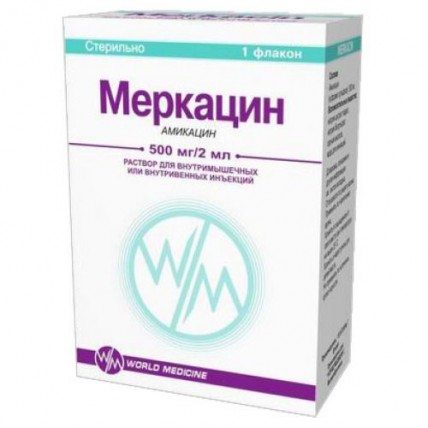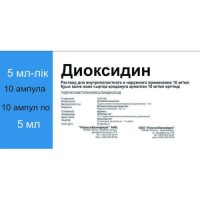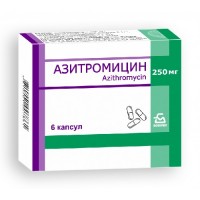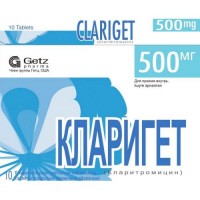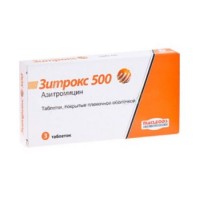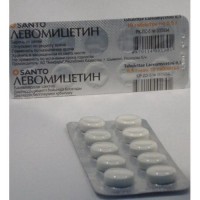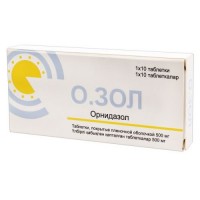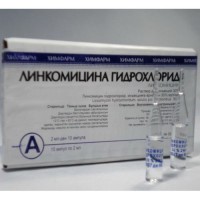Merkatsin 500 mg / 2 ml 2 ml solution for injection
- $11.20
The instruction for medical use
of MERKATsIN medicine
the Trade name
Merkatsin
Mezhdunarodnoye the unlicensed
name Amikacin Dosage Form Solution for injections, 100 mg / 2 ml and 500 mg / 2 ml
Structure
of 2 ml of solution contain
active agent – sulfate amikacin (in terms of amikacin) 100 mg or 500 mg,
excipients: sodium citrate anhydrous, sodium metabisulphite, sulphuric acid, water for injections.
The description
Colourless transparent solution
Pharmacotherapeutic group
Other aminoglycosides
the Code of automatic telephone exchange J01GB06
the Pharmacological
Pharmacokinetics Absorption Later properties of intramuscular introduction (in oil) is soaked up by Merkatsin quickly soaked up and distributed in all body tissues. The maximum concentration in blood plasma at intramuscular administration of drug in a dose of 7.5 mg/kg – 21 mkg/ml in 1.5 hours after intravenous (in / c) infusions in a dose of 7.5 mg/kg 38 mkg/ml within 30 min.
Distribution
Linking with proteins of plasma up to 20%. Well gets and it is distributed in extracellular liquid. In therapeutic concentration amikacin is found in pericardiac, lymphatic, peritoneal and synovial fluid. In higher concentrations it is found in urine, and in low concentration – in a bronchial secret, bile, breast milk, a phlegm and cerebrospinal fluid.
In fabrics amikacin collects intracellularly. In a liver, lungs, a spleen, kidneys and other bodies with a good blood-groove high concentrations of amikacin, and in fatty tissue, muscles and bones – lower concentration are noted.
At adults with the intact blood-brain barrier the concentration of drug in cerebrospinal fluid makes 10 – 20% of concentration in plasma, at inflammation of a meninx the permeability increases a little (to 50%). At newborns higher concentrations in cerebrospinal fluid, than at adults are reached.
Amikacin gets through a placental barrier and reaches essential concentration in blood of a fruit and amniotic liquid.
Distribution volume adults – 0.26 l/kg, at children have 0.2-0.4 l/kg, at newborns at the age of less than 1 week and with body weight less than 1.5 kg – up to 0.68 l/kg, at the age of less than 1 week and with a body weight more than 1.5 kg – up to 0.58 l/kg, at the patients having a mucoviscidosis - 0.3-0.39 l/kg.
Average therapeutic concentration at intravenous or intramuscular administration remains within 10-12 hours.
Removal
Elimination half-life (T1/2) in a terminal (b) phase the adults – 2-3 hours, at newborns have 5-8 hours, children of more advanced age have 2.5-4 hours.
Final size T1/2 – more than 100 hours.
It is removed with urine in not changed look by glomerular filtration (about 87% within 6 hours, 94% - per day).
Renal clearance – 79 – 100 ml/min.
Pharmacokinetics in special clinical cases
In a renal failure at adults of T1/2 (depending on extent of disturbance) – till 100 o'clock, at the patients having a mucoviscidosis – 1-2 h.
At patients with burns and a hyperthermia of T1/2 can be much less in comparison with average values owing to the increased clearance.
To be removed at a hemodialysis (50% in 4-6 hours), peritoneal dialysis is less effective (25% in 48-72 hours).
Pharmacodynamics
Antibiotic of group of aminoglycosides. The semi-synthetic antibiotic of a broad spectrum of activity, works bakteritsidno. Contacting 30S a subunit of ribosomes, interferes with formation of a complex transport and template-RNA, blocks protein synthesis and also destroys cytoplasmic membranes of bacteria.
Merkatsin is highly active concerning gram-negative microorganisms: Klebsiella spp, Pseudomonas aeroginosa, E.Coli, Proteus, Enterobacter spp, Serratia spp, Shigella spp, Salmonella, Providencia stuartii, Mima-Herelea, Citobacter freundii (including, the strains resistant to Kanamycinum, gentamycin, Tobramycinum) and also some gram-positive microorganisms: Staphylococcus spp (including, strains resistant to penicillin, Methicillinum, some cephalosporins), some strains of Streptococcus spp. It is not active concerning anaerobe bacterias.
At co-administration with benzylpenicillin synergism concerning Enterococcus faecalis strains is shown.
Indications
Treatment infectious – the inflammatory diseases of a heavy course caused by microorganisms sensitive to the drug Merkatsin and also microorganisms resistant to other aminoglycosides:
- an infection of an abdominal cavity (including peritonitis)
- a septic endocarditis
- sepsis
- infections of the central nervous system (including meningitis)
- upper respiratory tract infections (bronchitis, pneumonia, a pleura empyema, abscess of lungs)
- purulent infections of skin and soft tissues (including the infected burns infected ulcers and decubituses of various genesis)
- often recurrent infections of urinogenital ways (pyelonephritis, cystitis, an urethritis, prostatitis, gonorrhea)
- infections of biliary tract
- infections of bones and joints (including osteomyelitis)
- a wound fever and postoperative infections
the Route of administration and doses
the Mode of dosing is set individually at the rate of the body weight of the patient taking into account weight of a course and localization of an infection and also sensitivity of the activator. To adults and children from 12 years appoint in oil, in/in (struyno, within 2 minutes or by drop infusion) 5 mg/kg each 8 hours or on 7.5 mg/kg each 12 hours within 7-10 days.
For adults the maximum doses – up to 15 mg/kg a day, but no more than 1.5 g a day.
In respiratory infection, a septicaemia, infectious diseases of urinogenital ways, a febrile neutropenia the dose the adult makes 15 mg/kg in / century once a day.
In bacterial infections of urinary tract (uncomplicated) - to 250 mg there are each 12 hours, after the session of a hemodialysis the additional dose - 3-5 mg/kg can be appointed. The necessary dose of drug is parted in 100-200 ml of sterile solvent. Concentration of amikacin in solution for intravenous administration should not exceed 5 mg/ml. For drug solution preparation for intravenous administration it is recommended to use solvents: - 5% glucose solution for injections, - 5% solution of glucose and 0.2% chloride sodium solution for injections, - 5% solution of glucose and 0.45% chloride sodium solution for injections, - 0.9% chloride sodium solution for injections, - Ringera solution with a lactate for injections. Prepare solutions just before use. As well as all aminoglycosides, Merkatsin it is not necessary to enter along with other medicines. Merkatsin, as well as all medicines for parenteral administration, before use it is necessary to examine on existence of foreign particles! Treatment duration at intravenous administration - 3-7 days, at intramuscular introduction - 7-10 days. In case of lack of medical effect in 3-5 days of the beginning of administration of drug, reception it it is necessary to stop and double-check sensitivity of the activator to amikacin. To patients with impaired renal function (the clearance of creatinine can be required by Patients with burns a dose of 5-7.5 mg/kg each 4-6 h in connection with shorter T1/2 (1-1.5 h) at these patients.
Side effects
- ototoksichesky reactions of drug are shown in the form of a hearing impairment (reduction of perception of high-pitch tones) and disorders of a vestibular mechanism (dizziness). Frequency of developing of vestibular and acoustical disorders increases in a renal failure. Nephrotoxic effect of drug is characterized by increase in residual nitrogen of blood serum, decrease in clearance of creatinine, an oliguria, a proteinuria, a cylindruria and usually is reversible
- also allergic reactions are possible (skin rash, fever, a headache, etc.)
- development of phlebitis and periphlebites
Very seldom
- blockade of neuromuscular conductivity
of the Contraindication - hypersensitivity to drug components is possible and also to others to antibiotics of group of aminoglycosides - heavy dysfunctions of kidneys - neuritis of an acoustical nerve - pregnancy and the period of a lactation
- disturbance of a vestibular mechanism
Medicinal interactions
Merkatsin shows synergism in interaction with karbenitsilliny, benzylpenicillin, cephalosporins (at patients with heavy chronic kidney disease at combined use with a beta laktamnymi with antibiotics decrease in efficiency of aminoglycosides is possible). Development of nephrotoxic action can happen at simultaneous use of Merkatsin to Amphotericinum B, Vancomycinum, metoksiflurany, enflurany, non-steroidal anti-inflammatory drugs (NPVS), X-ray contrast means, cefalotin, cyclosporine, Cisplatinum, polymyxins, Acidum nalidixicum. Strengthens myorelaxation effect of kurarepodobny drugs. Metoksifluran, polymyxins for parenteral administration, kapreomitsin and other medicines blocking neuromuscular transmission (halogenated hydrocarbons as drugs for inhalation anesthesia, opioid analgetics), transfusion of large volume of blood with citrate preservatives - increase risk of an apnoea (especially at intraperitoneal introduction of Merkatsin). Parenteral administration of indometacin increases risk of development of toxic effect of aminoglycosides (increase in T1/2 and decrease in clearance). Amikacin reduces efficiency of medicines for treatment of a myasthenia. Pharmaceutical incompatibility In Merkatsin solution it is incompatible with penicillin, heparin, cephalosporins, kapreomitsiny, Amphotericinum B, a hydrochlorothiazide, erythromycin, nitrofurantoin, Tiopentonum, and also depending on concentration and composition of solution, - with vitamins of group B and C, with tetracyclines and potassium chloride.
Special instructions
the Patients receiving Merkatsin have to be under strict observation of the doctor, in view of potential ototoxicity and nephrotoxicity of aminoglycosides. Administration of drug over 14 days as safety of its use over this term is not established is not recommended. At emergence of signs of ototoxicity (sonitus, dizziness, decrease in hearing) or nephrotoxicity it is necessary to stop administration of drug or to make correction of its dose. The concomitant or consecutive use of other aminoglikozidny antibiotics and also other neurotoxic and nephrotoxic drugs is not recommended. The old age and a condition of dehydration also belongs to the factors increasing risk of development of toxic effects. It is necessary to apply with care aminoglikozidny antibiotics at patients with muscular disturbances, such as myastenia gravis or parkinsonism as this group of antibiotics can strengthen in addition muscle weakness because of potential kurarepodobny effect on neuromuscular transmission. At administration of drug Merkatsin can occur colonization by insensitive microorganisms, as well as in case of reception of other antibiotics that demands purpose of the corresponding treatment. During the Merkatsin drug treatment in order to avoid exceeding admissible norm of amikacin in an organism, it is recommended to define its concentration in blood serum. Concentration of amikacin in plasma should not exceed 25 mkg/ml (concentration of 15-25 mkg/ml is therapeutic). The risk of ototoxicity and nephrotoxicity is increased at patients with a renal failure, at use of high doses of drug and also at long-term treatment - in these cases it is recommended to carry out daily control of function of kidneys (values of concentration of creatinine in serum or clearance of creatinine). At unsatisfactory audiometric tests the dose of drug is reduced or stop treatment.
The feature influence of medicine on ability to run the vehicle or potentially dangerous mechanisms
during treatment needs to be careful at control of motor transport and potentially dangerous types of activity demanding the increased concentration of attention and speed of psychomotor reactions.
Overdose
Symptoms: an ataxy, dizziness, urination disorders, a loss of appetite, nausea, vomiting, a ring in ears, a hearing loss, breath disturbance. Treatment: for lifting the siege of neuromuscular transmission and its consequences - a hemodialysis or peritoneal dialysis, antikholinesterazny means, calcium salts, artificial ventilation of the lungs, symptomatic therapy.
A form of release and packing
Solution for intramuscular, intravenous injections in a bottle on 100 mg / 2 ml or 500 mg / 2 ml. 1 bottle in a cardboard box together with a leaf insert.
To Store storage conditions at a temperature not above 25 °C.
To store out of children's reach!
3 years
not to apply a period of storage after an expiration date.
Prescription status
According to the prescription
Producer E.I.P.I. To., Egypt
Tens ov City Ramadan,
the First B1 industrial zone,
p.o. box 149 Tens Proizvedeno for "UORLD MEDITSIN", Great Britain
to Develop
of MERKATsIN medicine
the Trade name
Merkatsin
Mezhdunarodnoye the unlicensed
name Amikacin Dosage Form Solution for injections, 100 mg / 2 ml and 500 mg / 2 ml
Structure
of 2 ml of solution contain
active agent – sulfate amikacin (in terms of amikacin) 100 mg or 500 mg,
excipients: sodium citrate anhydrous, sodium metabisulphite, sulphuric acid, water for injections.
The description
Colourless transparent solution
Pharmacotherapeutic group
Other aminoglycosides
the Code of automatic telephone exchange J01GB06
the Pharmacological
Pharmacokinetics Absorption Later properties of intramuscular introduction (in oil) is soaked up by Merkatsin quickly soaked up and distributed in all body tissues. The maximum concentration in blood plasma at intramuscular administration of drug in a dose of 7.5 mg/kg – 21 mkg/ml in 1.5 hours after intravenous (in / c) infusions in a dose of 7.5 mg/kg 38 mkg/ml within 30 min.
Distribution
Linking with proteins of plasma up to 20%. Well gets and it is distributed in extracellular liquid. In therapeutic concentration amikacin is found in pericardiac, lymphatic, peritoneal and synovial fluid. In higher concentrations it is found in urine, and in low concentration – in a bronchial secret, bile, breast milk, a phlegm and cerebrospinal fluid.
In fabrics amikacin collects intracellularly. In a liver, lungs, a spleen, kidneys and other bodies with a good blood-groove high concentrations of amikacin, and in fatty tissue, muscles and bones – lower concentration are noted.
At adults with the intact blood-brain barrier the concentration of drug in cerebrospinal fluid makes 10 – 20% of concentration in plasma, at inflammation of a meninx the permeability increases a little (to 50%). At newborns higher concentrations in cerebrospinal fluid, than at adults are reached.
Amikacin gets through a placental barrier and reaches essential concentration in blood of a fruit and amniotic liquid.
Distribution volume adults – 0.26 l/kg, at children have 0.2-0.4 l/kg, at newborns at the age of less than 1 week and with body weight less than 1.5 kg – up to 0.68 l/kg, at the age of less than 1 week and with a body weight more than 1.5 kg – up to 0.58 l/kg, at the patients having a mucoviscidosis - 0.3-0.39 l/kg.
Average therapeutic concentration at intravenous or intramuscular administration remains within 10-12 hours.
Removal
Elimination half-life (T1/2) in a terminal (b) phase the adults – 2-3 hours, at newborns have 5-8 hours, children of more advanced age have 2.5-4 hours.
Final size T1/2 – more than 100 hours.
It is removed with urine in not changed look by glomerular filtration (about 87% within 6 hours, 94% - per day).
Renal clearance – 79 – 100 ml/min.
Pharmacokinetics in special clinical cases
In a renal failure at adults of T1/2 (depending on extent of disturbance) – till 100 o'clock, at the patients having a mucoviscidosis – 1-2 h.
At patients with burns and a hyperthermia of T1/2 can be much less in comparison with average values owing to the increased clearance.
To be removed at a hemodialysis (50% in 4-6 hours), peritoneal dialysis is less effective (25% in 48-72 hours).
Pharmacodynamics
Antibiotic of group of aminoglycosides. The semi-synthetic antibiotic of a broad spectrum of activity, works bakteritsidno. Contacting 30S a subunit of ribosomes, interferes with formation of a complex transport and template-RNA, blocks protein synthesis and also destroys cytoplasmic membranes of bacteria.
Merkatsin is highly active concerning gram-negative microorganisms: Klebsiella spp, Pseudomonas aeroginosa, E.Coli, Proteus, Enterobacter spp, Serratia spp, Shigella spp, Salmonella, Providencia stuartii, Mima-Herelea, Citobacter freundii (including, the strains resistant to Kanamycinum, gentamycin, Tobramycinum) and also some gram-positive microorganisms: Staphylococcus spp (including, strains resistant to penicillin, Methicillinum, some cephalosporins), some strains of Streptococcus spp. It is not active concerning anaerobe bacterias.
At co-administration with benzylpenicillin synergism concerning Enterococcus faecalis strains is shown.
Indications
Treatment infectious – the inflammatory diseases of a heavy course caused by microorganisms sensitive to the drug Merkatsin and also microorganisms resistant to other aminoglycosides:
- an infection of an abdominal cavity (including peritonitis)
- a septic endocarditis
- sepsis
- infections of the central nervous system (including meningitis)
- upper respiratory tract infections (bronchitis, pneumonia, a pleura empyema, abscess of lungs)
- purulent infections of skin and soft tissues (including the infected burns infected ulcers and decubituses of various genesis)
- often recurrent infections of urinogenital ways (pyelonephritis, cystitis, an urethritis, prostatitis, gonorrhea)
- infections of biliary tract
- infections of bones and joints (including osteomyelitis)
- a wound fever and postoperative infections
the Route of administration and doses
the Mode of dosing is set individually at the rate of the body weight of the patient taking into account weight of a course and localization of an infection and also sensitivity of the activator. To adults and children from 12 years appoint in oil, in/in (struyno, within 2 minutes or by drop infusion) 5 mg/kg each 8 hours or on 7.5 mg/kg each 12 hours within 7-10 days.
For adults the maximum doses – up to 15 mg/kg a day, but no more than 1.5 g a day.
In respiratory infection, a septicaemia, infectious diseases of urinogenital ways, a febrile neutropenia the dose the adult makes 15 mg/kg in / century once a day.
In bacterial infections of urinary tract (uncomplicated) - to 250 mg there are each 12 hours, after the session of a hemodialysis the additional dose - 3-5 mg/kg can be appointed. The necessary dose of drug is parted in 100-200 ml of sterile solvent. Concentration of amikacin in solution for intravenous administration should not exceed 5 mg/ml. For drug solution preparation for intravenous administration it is recommended to use solvents: - 5% glucose solution for injections, - 5% solution of glucose and 0.2% chloride sodium solution for injections, - 5% solution of glucose and 0.45% chloride sodium solution for injections, - 0.9% chloride sodium solution for injections, - Ringera solution with a lactate for injections. Prepare solutions just before use. As well as all aminoglycosides, Merkatsin it is not necessary to enter along with other medicines. Merkatsin, as well as all medicines for parenteral administration, before use it is necessary to examine on existence of foreign particles! Treatment duration at intravenous administration - 3-7 days, at intramuscular introduction - 7-10 days. In case of lack of medical effect in 3-5 days of the beginning of administration of drug, reception it it is necessary to stop and double-check sensitivity of the activator to amikacin. To patients with impaired renal function (the clearance of creatinine can be required by Patients with burns a dose of 5-7.5 mg/kg each 4-6 h in connection with shorter T1/2 (1-1.5 h) at these patients.
Side effects
- ototoksichesky reactions of drug are shown in the form of a hearing impairment (reduction of perception of high-pitch tones) and disorders of a vestibular mechanism (dizziness). Frequency of developing of vestibular and acoustical disorders increases in a renal failure. Nephrotoxic effect of drug is characterized by increase in residual nitrogen of blood serum, decrease in clearance of creatinine, an oliguria, a proteinuria, a cylindruria and usually is reversible
- also allergic reactions are possible (skin rash, fever, a headache, etc.)
- development of phlebitis and periphlebites
Very seldom
- blockade of neuromuscular conductivity
of the Contraindication - hypersensitivity to drug components is possible and also to others to antibiotics of group of aminoglycosides - heavy dysfunctions of kidneys - neuritis of an acoustical nerve - pregnancy and the period of a lactation
- disturbance of a vestibular mechanism
Medicinal interactions
Merkatsin shows synergism in interaction with karbenitsilliny, benzylpenicillin, cephalosporins (at patients with heavy chronic kidney disease at combined use with a beta laktamnymi with antibiotics decrease in efficiency of aminoglycosides is possible). Development of nephrotoxic action can happen at simultaneous use of Merkatsin to Amphotericinum B, Vancomycinum, metoksiflurany, enflurany, non-steroidal anti-inflammatory drugs (NPVS), X-ray contrast means, cefalotin, cyclosporine, Cisplatinum, polymyxins, Acidum nalidixicum. Strengthens myorelaxation effect of kurarepodobny drugs. Metoksifluran, polymyxins for parenteral administration, kapreomitsin and other medicines blocking neuromuscular transmission (halogenated hydrocarbons as drugs for inhalation anesthesia, opioid analgetics), transfusion of large volume of blood with citrate preservatives - increase risk of an apnoea (especially at intraperitoneal introduction of Merkatsin). Parenteral administration of indometacin increases risk of development of toxic effect of aminoglycosides (increase in T1/2 and decrease in clearance). Amikacin reduces efficiency of medicines for treatment of a myasthenia. Pharmaceutical incompatibility In Merkatsin solution it is incompatible with penicillin, heparin, cephalosporins, kapreomitsiny, Amphotericinum B, a hydrochlorothiazide, erythromycin, nitrofurantoin, Tiopentonum, and also depending on concentration and composition of solution, - with vitamins of group B and C, with tetracyclines and potassium chloride.
Special instructions
the Patients receiving Merkatsin have to be under strict observation of the doctor, in view of potential ototoxicity and nephrotoxicity of aminoglycosides. Administration of drug over 14 days as safety of its use over this term is not established is not recommended. At emergence of signs of ototoxicity (sonitus, dizziness, decrease in hearing) or nephrotoxicity it is necessary to stop administration of drug or to make correction of its dose. The concomitant or consecutive use of other aminoglikozidny antibiotics and also other neurotoxic and nephrotoxic drugs is not recommended. The old age and a condition of dehydration also belongs to the factors increasing risk of development of toxic effects. It is necessary to apply with care aminoglikozidny antibiotics at patients with muscular disturbances, such as myastenia gravis or parkinsonism as this group of antibiotics can strengthen in addition muscle weakness because of potential kurarepodobny effect on neuromuscular transmission. At administration of drug Merkatsin can occur colonization by insensitive microorganisms, as well as in case of reception of other antibiotics that demands purpose of the corresponding treatment. During the Merkatsin drug treatment in order to avoid exceeding admissible norm of amikacin in an organism, it is recommended to define its concentration in blood serum. Concentration of amikacin in plasma should not exceed 25 mkg/ml (concentration of 15-25 mkg/ml is therapeutic). The risk of ototoxicity and nephrotoxicity is increased at patients with a renal failure, at use of high doses of drug and also at long-term treatment - in these cases it is recommended to carry out daily control of function of kidneys (values of concentration of creatinine in serum or clearance of creatinine). At unsatisfactory audiometric tests the dose of drug is reduced or stop treatment.
The feature influence of medicine on ability to run the vehicle or potentially dangerous mechanisms
during treatment needs to be careful at control of motor transport and potentially dangerous types of activity demanding the increased concentration of attention and speed of psychomotor reactions.
Overdose
Symptoms: an ataxy, dizziness, urination disorders, a loss of appetite, nausea, vomiting, a ring in ears, a hearing loss, breath disturbance. Treatment: for lifting the siege of neuromuscular transmission and its consequences - a hemodialysis or peritoneal dialysis, antikholinesterazny means, calcium salts, artificial ventilation of the lungs, symptomatic therapy.
A form of release and packing
Solution for intramuscular, intravenous injections in a bottle on 100 mg / 2 ml or 500 mg / 2 ml. 1 bottle in a cardboard box together with a leaf insert.
To Store storage conditions at a temperature not above 25 °C.
To store out of children's reach!
3 years
not to apply a period of storage after an expiration date.
Prescription status
According to the prescription
Producer E.I.P.I. To., Egypt
Tens ov City Ramadan,
the First B1 industrial zone,
p.o. box 149 Tens Proizvedeno for "UORLD MEDITSIN", Great Britain
to Develop
